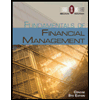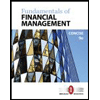
EP APLIA FOR BRIGHAM/HOUSTON'S FUNDAMEN
9th Edition
ISBN: 9781337697705
Author: Brigham
Publisher: Cengage Learning
expand_more
expand_more
format_list_bulleted
Question
Chapter 8, Problem 3DQ
Summary Introduction
To identify: Company, which have high and low beta coefficient.
Beta Coefficient:
Beta coefficient evaluates the sensitivity of the stock in comparison with the market. It is a historical measure. It means it only takes past information into account.
Expert Solution & Answer
Want to see the full answer?
Check out a sample textbook solution
Students have asked these similar questions
Hello experts Answer should be match in options. Many experts are giving incorrect answer they are using AI /Chatgpt that is generating wrong answer.
i will give unhelpful if answer will not match in option.
dont use AI also
3. Owen expects to receive $20,000 at the beginning of next year from a trust fund. If a
bank loans money at an interest rate of 7.5%, how much money can he borrow from
the bank based on this information?
A. $12879.45
B. $12749.67
C. $15567.54
D. $174537.34
TASK DESCRIPTION
Children
educatio Personali Cross-
n
ty
cultural
Spouse's
willingne allowanc
ss to
travel
Spouseoverseas
job
assistanc
compete Prior
ncies internati
onal
experienc
Age
Host
country
housing
assistanc
Income
tax
equalisati
on policy
Overseas
health
care plan
Length of
the
foreign
assignme Career
nt
and
repatriati
Receptivity
to
Internation
al Careers
Family
status
Gender
Marital
status
Educatio
n
Destinati
Opportun on
on Company ities for country
planning culture
career
support
(Tarique et al., 2015)
Tarique et al. (2015) developed the receptivity to international careers framework. Reflecting on
generational differences in contemporary organisations, you are required to evaluate this model
critically by addressing the following:
1. Identify the factors that are more important to Gen X, Gen Y, and Gen Z in their receptivity to
international assignments. (1,500 words)
2. Critically discusses how factors such as culture, personality and skills/experience may impact…
Chapter 8 Solutions
EP APLIA FOR BRIGHAM/HOUSTON'S FUNDAMEN
Ch. 8 - Suppose you owned a portfolio consisting of...Ch. 8 - Prob. 2QCh. 8 - Prob. 3QCh. 8 - Is it possible to construct a portfolio of...Ch. 8 - Stock A has an expected return of 7%, a standard...Ch. 8 - A stock had a 12% return last year, a year when...Ch. 8 - If investors aversion to risk increased, would the...Ch. 8 - Prob. 8QCh. 8 - In Chapter 7, we saw that if the market interest...Ch. 8 - Prob. 1P
Ch. 8 - PORTFOLIO BETA An individual has 20,000 invested...Ch. 8 - Prob. 3PCh. 8 - Prob. 4PCh. 8 - BETA AND REQUIRED RATE OF RETURN A stock has a...Ch. 8 - EXPECTED RETURNS Stocks A and B have the following...Ch. 8 - PORTFOLIO REQUIRED RETURN Suppose you are the...Ch. 8 - Prob. 8PCh. 8 - REQUIRED RATE OF RETURN Stock R has a beta of 2.0,...Ch. 8 - Prob. 10PCh. 8 - CAPM AND REQUIRED RETURN Calculate the required...Ch. 8 - REQUIRED RATE OF RETURN Suppose rRF = 4%, rM =...Ch. 8 - CAPM, PORTFOLIO RISK, AND RETURN Consider the...Ch. 8 - PORTFOLIO BETA Suppose you held a diversified...Ch. 8 - Prob. 15PCh. 8 - CAPM AND PORTFOLIO RETURN You have been managing a...Ch. 8 - PORTFOLIO BETA A mutual fund manager has a 20...Ch. 8 - EXPECTED RETURNS Suppose you won the lottery and...Ch. 8 - EVALUATING RISK AND RETURN Stock X has a 10%...Ch. 8 - REALIZED RATES OF RETURN Stocks A and 13 have the...Ch. 8 - SECURITY MARKET LINE You plan to invest in the...Ch. 8 - Prob. 22SPCh. 8 - Prob. 23ICCh. 8 - Prob. 1DQCh. 8 - Prob. 2DQCh. 8 - Prob. 3DQCh. 8 - Select one of the four stocks listed in Question 3...Ch. 8 - Go back to the summary page to see an estimate of...Ch. 8 - Prob. 6DQCh. 8 - Prob. 7DQCh. 8 - Beta pf CPB company Beta of the MSI Company is...
Knowledge Booster
Learn more about
Need a deep-dive on the concept behind this application? Look no further. Learn more about this topic, finance and related others by exploring similar questions and additional content below.Similar questions
- Listen Answer should be match in options. Many experts are giving incorrect answer they are using AI /Chatgpt that is generating wrong answer. i will give unhelpful if answer will not match in option. dont use AI alsoarrow_forwardPlease Answer should be match in options. Many experts are giving incorrect answer they are using AI /Chatgpt that is generating wrong answer. i will give unhelpful if answer will not match in option. dont use AI alsoarrow_forwardAnswer should be match in options. Many experts are giving incorrect answer they are using AI /Chatgpt that is generating wrong answer. i will give unhelpful if answer will not match in option. dont use AI alsoarrow_forward
- Toodles Inc. had sales of $1,840,000. administrative and selling expenses, and depreciation expenses were Cost of goods sold, $1,180,000, $185,000 and $365,000 respectively. In addition, the company had an interest expense of $280,000 and a tax rate of 35 percent. (Ignore any tax loss carry-back or carry-forward provisions.) Arrange the financial information for Toodles Inc. in statement and compute its OCF? an incomearrow_forwardFootfall Manufacturing Ltd. reports information at the end of the current year: Net Sales $100,000 Debtor's turnover ratio (based on 2 net sales) Inventory turnover ratio 1.25 Fixed assets turnover ratio 0.8 Debt to assets ratio 0.6 Net profit margin 5% Gross profit margin 25% Return on investment 2% the following financial Use the given information to fill out the templates for income statement and balance sheet given below: Income Statement of Footfall Manufacturing Ltd. for the year ending December 31, 20XX (in $) Sales 100,000 Cost of goods sold Gross profit Other expenses Earnings before Lax Tax @50% Earnings tax afterarrow_forwardTASK DESCRIPTION This assignment is comprised of two discrete tasks that each align with one of the learning outcomes described above. One is an informal report based on a five-year evaluation of the financial management and performance of a London Stock Exchange (LSE) FTSE 100 listed company. This report relates to learning outcome one. The second task, covering learning outcome two, is an essay on a particular aspect of financial-decision making and the main issues and theoretical frameworks related to the topic. Task one (Informal business report) Students are required to choose a public listed company from a given list of familiar United Kingdom (UK) firms whose shares are traded on the London Stock Exchange's FTSE 100 index, download its most recent annual report(s) covering financial statements for the past five years, and from the data presented produce an informal report of approximately 3,000 words which includes a critical overall analysis of its financial performance over…arrow_forward
- Write as like research paper: abstrac,litut review,model.current problem questionire,table,graph, charts, image, analysis, result,conclusion, referencce15-20 1. Provide literature as research paper" liturature review" content as journal 2. article,textbooks.current newspaper article.organizational doccument and website **citation as liturature citation reference 15-20 in liturature review content paragraph. 2. Show latest problem of current knowledge ang give a **model immage, and display show awareness of that problem and questionire. 3. Current that research methodology.show graph.table.chrts.assesment task 4. Design and Result,5. Conclution, 6. Referance 15-20 TASK DESCRIPTION Children educatio Spouse's willingn allowanc travel Spouseoverseas job assistanc Host country housing assistanc Income tax equalisati on policy Overseas health care plan Length of the foreign assignme dareer and repatriati Cross- Personali cultural compete Prior ncies internati Receptivity to Internation al…arrow_forwardWrite in memo format a response to your Manager, based on the information presented below for the Duncan Company and also based on your additional research. Your Manager has advised you to make any assumptions where necessary. Duncan Company is a large manufacturer and distributor of cake supplies. It is based in United Kingdon (Headquarters) It sends supplies to firms throughout the United States and the Caribbean . It markets its supplies through periodic mass mailings of catalogues to those firms. Its clients can make orders over the phone and Duncan ships the supplies upon demand. The main competition for Duncan’s comes from one U.S. firm and one Canadian firm. Another British firm has a small share of the U.S. market but is at a disadvantage because of its distance. The British firm’s marketing and transportation costs in the U.S. market are relatively high. a) Duncan Company plans to penetrate either the Canadian market or two other Caribbean Countries (Jamaica and Haiti). What…arrow_forwardAnswer of the question in the picturearrow_forward
- A sporting goods manufacturer has decided to expand into a related business. Management estimates that to build and staff a facility of the desired size and to attain capacity operations would cost $450 million in present value terms. Alternatively, the company could acquire an existing firm or division with the desired capacity. One such opportunity is a division of another company. The book value of the division’s assets is $250 million and its earnings before interest and tax are presently $50 million. Publicly traded comparable companies are selling in a narrow range around 12 times current earnings. These companies have book value debt-to-asset ratios averaging 40 percent with an average interest rate of 10 percent. a. Using a tax rate of 34 percent, estimate the minimum price the owner of the division should consider for its sale. b. What is the maximum price the acquirer should be willing to pay? c. Does it appear that an acquisition is feasible? Why or why not? d. Would a 25…arrow_forwardLarry Davis borrows $80,000 at 14 percent interest toward the purchase of a home. His mortgage is for 25 years. a. How much will his annual payments be? (Although home payments are usually on a monthly basis, we shall do our analysis on an annual basis for ease of computation. We will get a reasonably accurate answer.) b. How much interest will he pay over the life of the loan? c. How much should be willing to pay to get out of a 14 percent mortgage and into a 10 percent mortgage with 25 years remaining on the mortgage? Assume current interest rates are 10 percent. Carefully consider the time value of money. Disregard taxes.arrow_forwardYou are chairperson of the investment fund for the local closet. You are asked to set up a fund of semiannual payments to be compounded semiannually to accumulate a sum of $250,000 after nine years at a 10 percent annual rate (18 payments). The first payment into the fund is to take place six months from today, and the last payment is to take place at the end of the ninth year. Determine how much the semiannual payment should be. (a) On the day, after the sixth payment is made (the beginning of the fourth year), the interest rate goes up to a 12 percent annual rate, and you can earn a 12 percent annual rate on funds that have been accumulated as well as all future payments into the funds. Interest is to be compounded semiannually on all funds. Determine how much the revised semiannual payments should be after this rate change (there are 12 payments and compounding dates). The next payment will be in the middle of the fourth year.arrow_forward
arrow_back_ios
SEE MORE QUESTIONS
arrow_forward_ios
Recommended textbooks for you
 Fundamentals of Financial Management, Concise Edi...FinanceISBN:9781285065137Author:Eugene F. Brigham, Joel F. HoustonPublisher:Cengage Learning
Fundamentals of Financial Management, Concise Edi...FinanceISBN:9781285065137Author:Eugene F. Brigham, Joel F. HoustonPublisher:Cengage Learning Fundamentals of Financial Management, Concise Edi...FinanceISBN:9781305635937Author:Eugene F. Brigham, Joel F. HoustonPublisher:Cengage Learning
Fundamentals of Financial Management, Concise Edi...FinanceISBN:9781305635937Author:Eugene F. Brigham, Joel F. HoustonPublisher:Cengage Learning

Fundamentals of Financial Management, Concise Edi...
Finance
ISBN:9781285065137
Author:Eugene F. Brigham, Joel F. Houston
Publisher:Cengage Learning

Fundamentals of Financial Management, Concise Edi...
Finance
ISBN:9781305635937
Author:Eugene F. Brigham, Joel F. Houston
Publisher:Cengage Learning
Investing For Beginners (Stock Market); Author: Daniel Pronk;https://www.youtube.com/watch?v=6Jkdpgc407M;License: Standard Youtube License